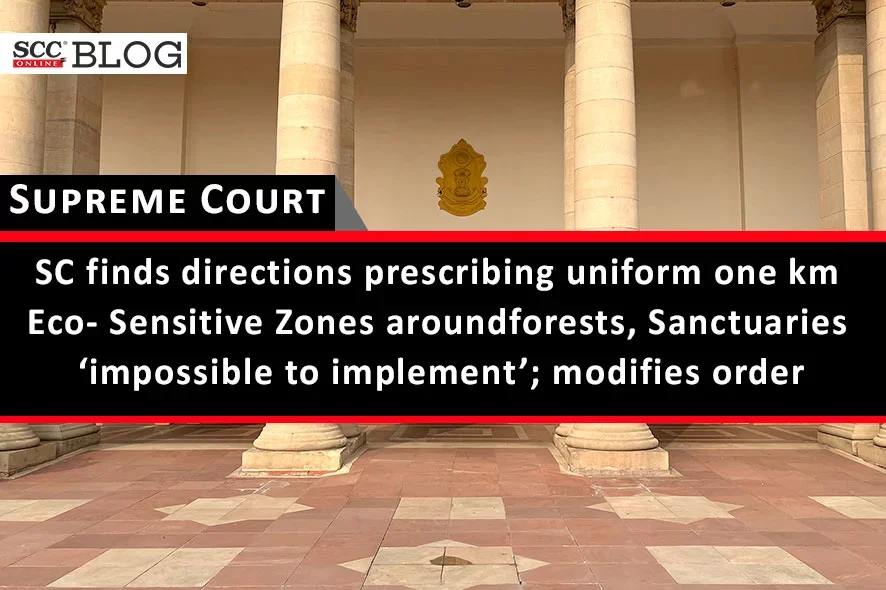Supreme Court: In an interlocutory application filed by the Union of India (‘applicant’), seeking modification and clarification of the order passed by the Court regarding the Eco- Sensitive Zones (ESZs). The three-Judge Bench of B.R Gavai*, Vikram Nath and Sanjay Karol, J.J., allowed the application and modified the previously issued directions on the grounds that the directions prescribing a uniform one km ESZs area, was impossible to be implemented knowing that millions of people are residing around these protected areas.
Background
The order dated 03-06-2022 was passed by the Court, wherein it was directed that national parks and wildlife sanctuary to have ESZ within one kilometre (‘km’) area from the boundary of the protected forests. It was also directed that that there shall be no mining activities within the one km radius of protected forests. The applicant specifically sought modification of several directions passed by the Court, on the grounds that if the directions were not modified, a severe hardship would be caused to the millions of people residing around various national parks and wildlife sanctuaries.
Court’s Analysis
The Court said that the direction requiring the permission of Principal Chief Conservator of Forests (‘PCCF’) of each State or Union Territory for continuation of existing activities in ESZs was impossible to be implemented, considering the fact that in ESZs around various national parks and sanctuaries, hundreds of villages wherein millions of people are residing are situated.
The Court noted that if the directions sought to be modified, remains unmodified, then no permanent structure would be permitted to come up for whatsoever purpose in the ESZs. It was also noted that there are various regulated and permissible activities and projects of national and strategic importance such as construction of national highways, railways, defence related infrastructure, etc. in these areas.
Therefore, taking into consideration that there are hundreds of villages wherein millions of people are residing, the Court said that PCCF would be left with no other job except to consider such applications for permission to continue such activities, even a farmer desirous to continue farming activities would be required to seek such permission. The Court observed that the guidelines as per the order, were not to hamper day to day activities of the citizens but are meant to protect the precious forests/protected Areas from any negative impact.
The Court said that the direction prescribing a uniform one km ESZ area, was required to be modified, taking into consideration that there is no uniformity in the area surrounding the boundaries of the protected forests. It was noted that in some cases, it may be 10 km on one side and 500 metres on the other side, thus it may not be possible to have a uniform minimum area by virtue of inter-state boundaries or a sea or a river beyond one side of the protected Area.
The Court noted there is a detailed procedure required to be followed as prescribed under Rule 5 of the 1986 Rules to declare an ESZ, following an expertise to be sought from the Expert Committee consisting of 13 organizations, having expertise in the said field. Further, the Court noted that as per sub-rule (3) of Rule 5 of the Environment (Protection) Rules, 1986 (‘1986 Rules’), before any final notification is issued, a draft notification is required to be published in the Official Gazette and in such other manner as the Central Government may deem necessary from time to time.
Therefore, the Court clarified that such direction prescribing one km ESZs area, would not be applicable to the ESZs in respect of which a draft and final notification has already been issued by the Ministry of Environment, Forest and Climate Change (‘MoEF and CC’) and in respect of the proposals which have been received by the Ministry. It was also said that this direction would not be applicable where the National Parks and Sanctuaries are located on inter-State borders and/or share common boundaries.
The Court also said that as far as question of restriction on mining in the ESZs is concerned, the Courts have always had a consistent view that mining activities within an area of one km of the boundary of the protected areas would be hazardous for the wildlife. The Court also viewed that the directions issued in Goa Foundation v. Union of India, (2014) 6 SCC 590, needs to be issued on Pan-India basis.
Thus, the previous directions were modified, and the Court issued certain new directions:
- that wide publicity should be given to the draft notification which is required to be published under the provisions of clause (a) of sub-rule (3) of Rule 5 of the 1986 Rules,
- that the final notification to be published under clause (d) of sub-rule (3) of Rule 5 of the 1986 Rules shall not be given effect for a period of 30 days from the date of issuance thereof,
- that any person who is aggrieved with such a final notification would be entitled to approach the Court directly by filing an application in the present proceedings,
- that mining within the National Park and Wildlife Sanctuary and within an area of one kilometre from the boundary of such National Park and Wildlife Sanctuary shall not be permissible,
- the MoEF and CC and all the State/Union Territory Governments shall strictly follow the provisions in the guidelines issued by Government of India, dated 09-02-2011 providing a detailed procedure for submitting a proposal for declaration of the areas around National Parks and Wildlife Sanctuaries as ESZs, and
-
that while granting Environmental and Forest Clearances for project activities in ESZ and other areas outside the Protected Areas, the Union of India as well as various State/Union Territory Governments shall strictly follow the provisions contained in the Office Memorandum dated 17th May 2022 issued by MoEF and CC.
[In Re: T.N. Godavarman Thirumulpad v. Union of India, 2022 SCC OnLine SC 1318, Decided on 26-04-2022]
Judgment Authored by: Justice B.R. Gavai







